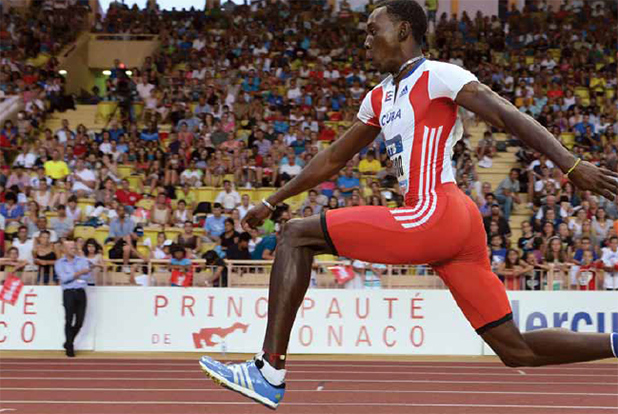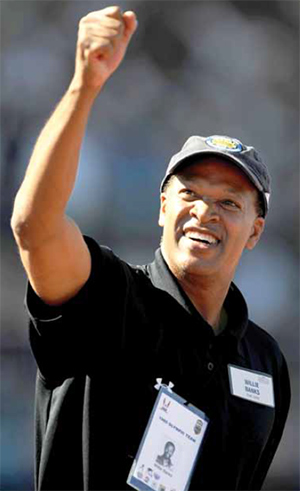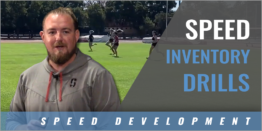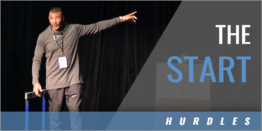|
Stepping Up - Correcting errors to improve By: Willie Banks Originally Published in Techniques Magazine - USTFCCCA
The triple jump had a banner year in 2015 as Christian Taylor won in Beijing with an American record 18.21 meters (59-9) and Cuba's Pedro Pichardo twice exceeded 18 meters (59-0 3/4). But 30 years after I set a world record of 17.97 (58-11 1/2) and 20 years after Jonathan Edwards jumped the still-standing best of 18.29 (60-0 1/4), the event is suffering. Reliance on the double-arm takeoff is handicapping athletes. Jumping too high in the hop phase and not focusing on swing-leg speed in the step phase are other mistakes. Correcting these and other issues at the elite levels could make a 19-meter (62-4) jump possible. Origin of Errors
Many coaches had their athletes mimic movements of the best, not knowing whether they were doing the right thing. For example, after Bulgaria's Khristo Markov won at the 1988 Olympics, a lot of athletes switched to his technique. It featured an over-the-head arching arm that came crashing down in front of him as he hit the ground in his hop leading to his step phase. It was almost a long jump arm swing above the head, which helps prevent upper body rotation in that event. Coaches failed to understand the error in his jumps, and didn't take into account his tremendous leg power. Today we understand this type of arm movement results in undue downward forces being generated from the hop into the step phase. The significant thing about Markov missed by many coaches was that the whole body lined up perpendicular to the ground when his foot hit the surface of the ground, giving him the base of support to jump off the foot into the step. Any mistake in location leads to injury. Markov eventually succumbed to the injuries that is a natural result of this technique. Lack of high-quality research also led to mistaken notions about my approach run. When I was at the top of my game, I remember a coach telling me how confused the Eastern European coaches were about my run. They didn't understand why it was so long. My runup was only 16 strides. I added an additional eight "movements" (four walking strides and four pushing strides) as a way to build momentum, not as part of my actual run. The problem was that my run became about 50 meters, often too long for most runways. That meant that I often had to start my run on the side of the long jump pit on the opposite end of the runway. In some cases, my first eight strides were almost L-shaped. As long as I could fit my 16 strides in, I could start anywhere and still have an accurate run to the board. I had an "active" start rather than the typical "static" start. Copying my run was a mistake, but many people did. Any significant study at that time would have led to the conclusion that my run was too long. Mistakes Among Elites Today the best jumpers should be jumping mid- to high 18 meters. When I improved my step phase in 1988, I was able to reach 18 meters (59 feet) with an aiding wind. Had I not hurt my Achilles, I believe 18.50 (60-8 1/2) was very possible for me. With his size and power, Brazil's Jadel Gregorio is capable of jumping close to 19 meters. The limiting factor is the 13-meter length of the runway from the board to the pit. Eventually, officials will increase this distance, and marks will improve considerably, especially for athletes who take off using their long jump leg. Pichardo is the first Cuban I've seen use the proper takeoff and add the much needed jump phase at the end. Cuban coaches are doing fantastic things with their young athletes but fail to complete the job. Still, their young jumpers are learning the proper technique early. They have a base of plyometrics, bounding and speed to help them maximize the technique. U.S. high school coaches are not stressing the basic skills of the triple jump - bounding and "active landings." An active landing is "pawing" the ground like a horse. However, the basic meaning is to bring the support leg and swing leg together under the hips and attack the ground downward to produce an upward "bound" into the step or jump phase. At more advanced levels, coach Randy Huntington and his group are teaching the correct methods. Double-Arm Doubts A recurring argument is over the use of the double-arm technique at takeoff. But it is fairly clear that the use of a full double arm is a cumbersome way to take off in the triple jump. Anyone employing the technique exhibits a distinct slowdown in their run. The body naturally slows when arm action changes. You never see a sprinter put both arms down. In a study of of the world's elite men jumpers, it was shown that speed leading to the takeoff board correlates to the best jumps. (Kreyer 1992, Hutt 1988). As an extension of the studies, we can assume that the faster the speed in the last 5 to 6 meters of the runway, the better the jump will be. A single-arm takeoff allows athletes to maximize their speed. People point most frequently to Viktor Saneyev, the triple Olympic champion, as the example of the double-arm takeoff. But he was really using a 1.5-arm takeoff. A single arm takeoff is most efficient because the "hop" phase is not necessarily a jump - it is a "loaded" run off the board. (Yu 2008) The hips must push through the board and the swing leg must supply the upward drive, thus preventing a loss of speed caused by "gathering" to jump. Another errant arm action is when an athlete brings the arm above their shoulder and brings it down when hitting the ground from the hop to the step. This is a drastic mistake because it brings force down when force should be brought forward and up. Fixing the Arms Arms are critical because they affect the length of time on the ground, the jumper's balance and the angle of takeoff in each phase. The basic technique in the triple jump requires that the arms be coordinated with the legs. As an athlete gets more elite, arms and legs will move more independently and fluidly. Intuitively, the arms move in reaction to the opposite leg as in running. However, the triple jumper must learn to resist this natural movement and use the arms to generate speed and balance. Instead of the arm swinging back with the swing leg, the arm will stop and move forward, allowing the swing leg to move back independently. This allows the athlete to use the double-arm swing for the hop to step and step to jump. More research needs to be done to determine if the single-arm swing for the hop to step is more effective than the double. Recent observations may indicate, especially in women, that the single-arm action in the hop to step phase is the preferred technique. To train these actions, coordination drills are used. A coach should consider each appendage as an independent body. Create actions that will force the athlete to do one thing with her right arm and a completely different thing with her left arm. For example, rubbing your belly and patting your head. Turbine runs are helpful. The athlete swings his left arm from the shoulder in a circular motion from the top to front to bottom to back then up top again. Simultaneously, the right arm is going in the opposite direction - top to back to bottom to front to top again. This is like a turbine with rotors going in opposite directions. The athletes runs while making this arm action. As proficiency is gained, athletes are asked to do the same thing backwards. Arms must be trained independently. When I was a freshman at UCLA, Coach Tom Tellez made me walk around the track doing the double-arm action for a week. I was not happy about it, but I learned how to do that technique and soon became a national record holder. When I train my athletes, I do the same. We work on the arms independently and then add legs to the mix.
Studies are showing how double-arm takeoff athletes slow more in the last two steps into the takeoff board. I realized that the amount of speed lost in the double-arm takeoff was significant enough for me to change to a single-arm style. Bing Yu discovered that for the hop and step, the single-arm movement was the optimal motion. Conley was an exception, but in general the single-arm takeoff is much better for maintaining speed. The position of the body at takeoff deserves effective study - not just foot placement on the board. Even if an athlete can place a foot on the board, the hips can be three feet behind the board. A better jump results when the athlete's hips, at foot contact with the board, are a foot from the board and pushing off rather than spending time to pass the board before takeoff. Height and Angles The key to success is carrying speed throughout the three phases of touchdown. Jumpers who are "hop-dominant" have extremely high hops after takeoff, like a long or high jumper. This leads to a poor angle of landing and reduced quality of the step phase - ultimately a poor overall jump. Most hop-dominant jumpers use their long jump and high jump takeoff leg for the hop phase. This is a mistake because it takes away from the ability to convert the speed on the runway to forward momentum at takeoff. A good angle of takeoff, about 12 to 15 degrees, results in a superior speed throughout the jump. The swing leg should line up with the plant leg in each phase so that everything is perpendicular to the ground at touchdown (the point where the support leg hits the ground in the hop to step and the step to jump). This enables the athlete to move through the three phases with minimal loss of speed. Fixing the Angles Most coaches tell the athlete to "shorten the hop" or "don't jump so high." This doesn't address the athlete's needs. Jump height is determined by the angle of takeoff from the board, but that is directly related to the distance the athlete's center of mass is to the board relative to point of takeoff. In other words, it is directly related to how close the hips are to the foot at the board leading to takeoff. If you view Jonathan Edwards' video ( the jump can be viewed on YouTube here: youtube.com/watch?v=rgHYUDoG8_A) of his world record jump, you will notice that his body is tall when his foot hits the board and almost right above his foot like a sprinter. The next movement is a fast thigh drive and push off the board. The body is still erect, but the forward momentum results in him leaving the board after he has passed the board, which results in a fast, long, flat hop. The best way to illustrate this is to stand tall with both feet together. Take one foot and step back, keeping the other foot in the same spot. Next go back to two feet together. Finally, take one step forward, keeping the other foot in the same location. When the moving foot is behind you, that is the position for a high jump takeoff. When the feet are together, that is the position for the long jump takeoff. But when the moving foot is in front, that is the position for the triple jump. As illustrated in the Edwards video, if the foot is on the board and the body passed the board before the jump is attempted it will flatten the angle of takeoff and the athlete will achieve a significantly better overall triple jump. Ratio of Phases Before 1975, when de Oliveira broke Saneyev's mark, world record holders were all hop-dominant. Since then, every world record holder has been jump-dominant. The current elite athlete ratio (in percentages) is 34, 27, 39. Hay made a good point in his essay regarding the benefit of the jump-dominant athletes. He suggested that technique emphasizing the jump phase might be the optimum for most triple jumpers. (Hay 1995) But today the hop-dominant jumper is the most common, even thought they are not the most successful. It makes one wonder what coaches are studying. Women tend to have a hop-dominant style and their step phase is not as effective. Until coaches understand that a beginner should use their non-long-jump leg for the takeoff leg, they will hamper their athletes' ability to maximize their distance. Even if it seems intuitive to have the athlete use their long-jump leg twice, there is no evidence that the two jumps create a significant increase in the distance of the step phase to make up for the weak jump phase using the non-long-jumping leg. The speed is too slow to produce a good jump from the non-long-jumping leg. The limited runway also prevents the elite jumper from maximizing the hop step. Charlie Simpkins could jump 13 meters (42-8) on his hop and step but lacked real estate to complete the jump phase and always cut it short. This will continue to frustrate the best triple jump-ers who don't use the jump leg on the final phase. A novice jumper should be taught to emphasize a flat long hop. Women also should be steered toward a jump-dominant technique. But it is not as significant a change because they won't run out of runway on the hop and step. Need for Swing Speed Critical is the swing leg speed and position at touchdown in each phase. The swing leg must be in the "cylinder of force" when it passes the plant leg or the jump will be flat and the momentum of the jumper retarded. The "cylinder of force" is that area surrounding the foot as it hits the ground and all airspace above it. One of the best analysis of this technique can be found in the YouTube video by Brian Clymer, "A Closer look at Jonathan Edwards' WR Tr His explanation is excellent and the video shows clearly the position of the body and legs for best hop-step performance. The fact that Edwards stayed in the cylinder of force throughout the jump allows him to transfer the speed most efficiently. But if the athlete hits the ground with swing leg, hips, torso and head in alignment and above the foot, a quick and effortless jump will occur because force will push straight up through the head and push the body up and out. Thus it is important to speed up the swing leg to keep it in the cylinder of force on each jump. Long jumpers use a penultimate stride "rocking step" to produce upward movement. In the triple jump, it is best to "run" off the board. Fixing the Swing The swing leg must be aligned with the sup-port leg at touchdown from the top to the step and step to the jump phase. Doing less results in poor jumps. A regimen of quick bounds and hurdle hops is very useful for teaching this skill. In addition, attaching a pulley with weights to the athlete's thigh and doing short hops while swinging the leg attached to the pulleys will foster quicker and stronger swing leg drive. Conclusion My fastest 100 meters was 11 seconds. I couldn't squat better than 220 pounds, and my best bench press was about 176 pounds. I was 6 foot 3 inches and weighed about 172 pounds. Despite my enthusiasm for the event and technical studies, I failed to work on the weakest part of my jump -the step phase. I made many excuses and never fixed the problem, depending heavily on my jump phase to compensate for the failed step. If I had gotten a typical 38-foot hop and step - instead of staying around 36 feet - I could have gone over 60 feet. The next generation of triple jump greats will learn from these mistakes - shunning the double-arm takeoff and preserving speed through a flatter hop and better use of the swing leg in the latter phases.
Hay, J.G. & Miller, J.A. (1985). Techniques used in the triple jump. International Journal of Sport Biomechanics, 1, 185-196. Kreyer, V (1992) About the female triple jump. Legkaya Atletica Russia No. 3 March 1992. Hutt E. (1988). Model technique analysis sheet for the horizontal jumps: Part II. The triple jump. New Studies in Athletics, 4 (3), 63-66. Yu, B. (2008) Biomechanics of Triple Jump (2008). usati.org/groups/ Coaches/library/2008/Horizontal%20 Jumps/3DrBingYu.pdf Clymer, B. (2013) "A Closer look at Jonathan Edwards' WR Tr 2013 YouTube video analysis: youtube.com/ watchN=LwgIU4UqtMU 0
|




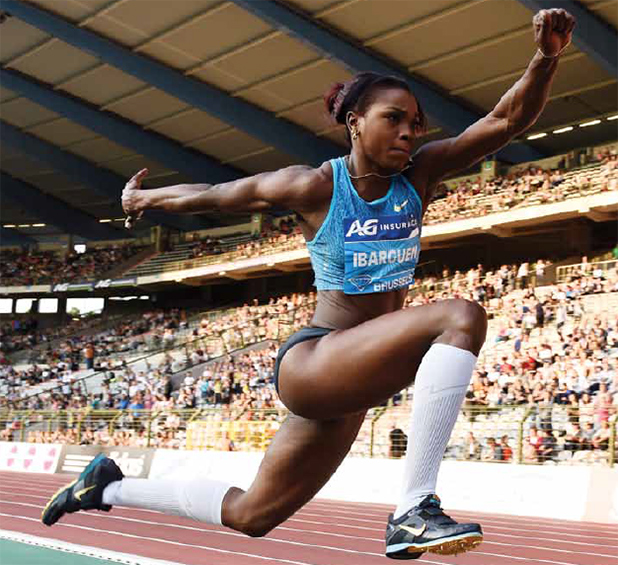
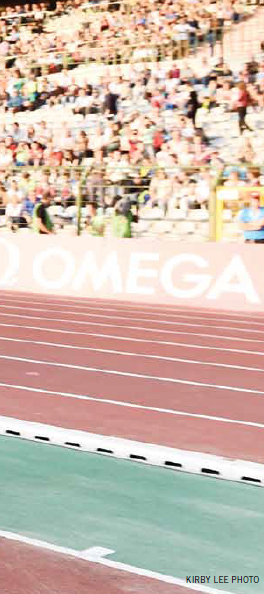 The triple jump used to be a secondary event - for those who fell short in sprints, pole vault, high jump or long jump. But it gave the average athlete a chance to be an important part of the team. Since the late 1980s, great athletes have focused on the triple jump. Mike Conley, Christian Olsson, Inessa Kravets, Tatyana Lebedeva, Will Claye and Taylor could and did add medals in other events. But with most athletes focusing on other jumps, less technical attention was given the triple jump.
The triple jump used to be a secondary event - for those who fell short in sprints, pole vault, high jump or long jump. But it gave the average athlete a chance to be an important part of the team. Since the late 1980s, great athletes have focused on the triple jump. Mike Conley, Christian Olsson, Inessa Kravets, Tatyana Lebedeva, Will Claye and Taylor could and did add medals in other events. But with most athletes focusing on other jumps, less technical attention was given the triple jump.
